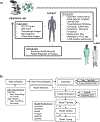Artificial Intelligence in Cancer Research and Precision Medicine
- PMID: 33811123
- PMCID: PMC8034385
- DOI: 10.1158/2159-8290.CD-21-0090
Artificial Intelligence in Cancer Research and Precision Medicine
Abstract
Artificial intelligence (AI) is rapidly reshaping cancer research and personalized clinical care. Availability of high-dimensionality datasets coupled with advances in high-performance computing, as well as innovative deep learning architectures, has led to an explosion of AI use in various aspects of oncology research. These applications range from detection and classification of cancer, to molecular characterization of tumors and their microenvironment, to drug discovery and repurposing, to predicting treatment outcomes for patients. As these advances start penetrating the clinic, we foresee a shifting paradigm in cancer care becoming strongly driven by AI. SIGNIFICANCE: AI has the potential to dramatically affect nearly all aspects of oncology-from enhancing diagnosis to personalizing treatment and discovering novel anticancer drugs. Here, we review the recent enormous progress in the application of AI to oncology, highlight limitations and pitfalls, and chart a path for adoption of AI in the cancer clinic.
©2021 American Association for Cancer Research.
Conflict of interest statement
CONFLICT OF INTEREST
CG and NM are co-founders, equity holders and employees of OneThree Biotech, a company that uses AI to develop new drugs. OE is co-founder and equity holder in OneThree Biotech.
Figures




References
-
- LeCun Y, Bengio Y, Hinton G. Deep Learning. Nature 2015:521:436–44. - PubMed
Publication types
MeSH terms
Substances
Grants and funding
LinkOut - more resources
Full Text Sources
Other Literature Sources
Medical
Research Materials

